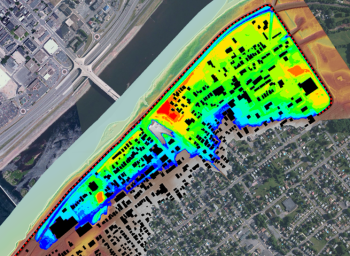Pre-Modeling Communication: Consequence Estimation Considerations: Difference between revisions
From ASDSO Dam Safety Toolbox
No edit summary |
No edit summary |
||
| Line 1: | Line 1: | ||
<!-- Default code to remove table of contents and add line break at top of page --> | |||
__NOTOC__ | |||
<!-- Add Category to drive breadcrumb menus --> | |||
[[Category: Model Work Plan]] | |||
---- | |||
{{Picture | {{Picture | ||
<!-- Add image file name (ex.image.jpg) --> | <!-- Add image file name (ex.image.jpg) --> | ||
| Line 9: | Line 15: | ||
}} | }} | ||
Prior to performing a consequence estimation analysis, the following modeling parameters and key assumptions should be considered and included in a model work plan as appropriate: | |||
* State the software selection and describe the limitations of the program as they apply to this project. | * State the software selection and describe the limitations of the program as they apply to this project. | ||
* Describe the scenarios to be modeled and any scenario-specific assumptions that will be applied. | * Describe the scenarios to be modeled and any scenario-specific assumptions that will be applied. | ||
| Line 16: | Line 23: | ||
* Describe how warning, intervention, and evacuation will be considered as part of the analysis. Warning time and the preparedness of communities to respond to emergency conditions can have a significant impact on overall consequences of a dam failure. Also describe the methodology that will be used to evaluate flood lethality should evacuation efforts fail. | * Describe how warning, intervention, and evacuation will be considered as part of the analysis. Warning time and the preparedness of communities to respond to emergency conditions can have a significant impact on overall consequences of a dam failure. Also describe the methodology that will be used to evaluate flood lethality should evacuation efforts fail. | ||
* If a parametric sensitivity analysis is planned, describe the approach. | * If a parametric sensitivity analysis is planned, describe the approach. | ||
''Development of this page was sponsored by the [[Montana | Montana Department of Natural Resources & Conservation]] with funding from the FEMA Assistance to States Grant Program.'' | |||
<!-- Revision history information --> | |||
{{revhistinf}} | |||
Revision as of 05:30, 25 June 2024

|
| 2D hydraulic modeling can be used to simulate and estimate the consequences of dam and levee failures.
(Image Source: Gannett Fleming) |
Prior to performing a consequence estimation analysis, the following modeling parameters and key assumptions should be considered and included in a model work plan as appropriate:
- State the software selection and describe the limitations of the program as they apply to this project.
- Describe the scenarios to be modeled and any scenario-specific assumptions that will be applied.
- Note the sources of information for project-specific input and model-specific parameters and describe the uncertainties or limitations of that information. Also identify data needs and how those gaps will be addressed.
- Describe the anticipated model extent and the associated source of flood inundation depth, velocity, and timing data. The analysis should extend far enough downstream that additional incremental consequences due to dam failure are not anticipated.
- Describe the source of population-at-risk estimates. This often consists of structure inventories that have population assigned to each structure point or footprint. Data should be recent and reflect current distribution of the population within the hazard area. If necessary, structure data should be supplemented with population estimates for major roadways, recreational areas, or other transient populations in the inundation area. Depending on the complexity of the analysis, data may need to reflect both daytime and nighttime populations or include structure type and size.
- Describe how warning, intervention, and evacuation will be considered as part of the analysis. Warning time and the preparedness of communities to respond to emergency conditions can have a significant impact on overall consequences of a dam failure. Also describe the methodology that will be used to evaluate flood lethality should evacuation efforts fail.
- If a parametric sensitivity analysis is planned, describe the approach.
Development of this page was sponsored by the Montana Department of Natural Resources & Conservation with funding from the FEMA Assistance to States Grant Program.
Revision ID: 7982
Revision Date: 06/25/2024
